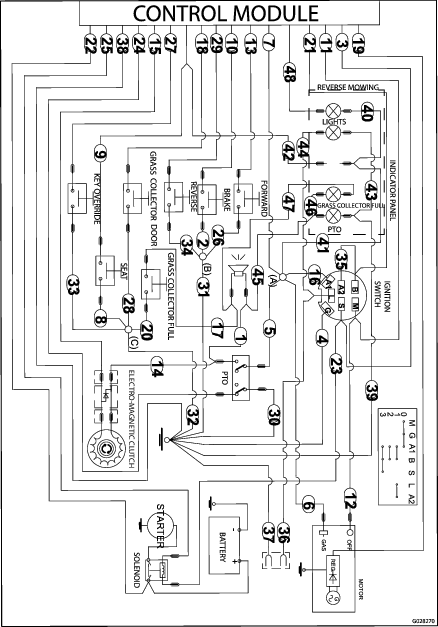| Maintenance Service Interval | Maintenance Procedure |
|---|---|
| Before each use or daily |
|
Introduction
This rotary-blade, riding lawn mower is intended to be used by residential homeowners. It is designed primarily for cutting grass on well-maintained lawns on residential properties. It is not designed for cutting brush or for agricultural uses.
Read this information carefully to learn how to operate and maintain your product properly and to avoid injury and product damage. You are responsible for operating the product properly and safely.
You may contact Toro directly at www.Toro.com for product and accessory information, help finding a dealer, or to register your product.
Whenever you need service, genuine Toro parts, or additional information, contact an Authorized Service Dealer or Toro Customer Service and have the model and serial numbers of your product ready. Figure 1 identifies the location of the model and serial numbers on the product. Write the numbers in the space provided.
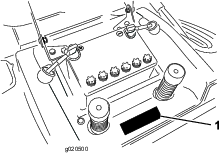
This manual identifies potential hazards and has safety messages identified by the safety alert symbol (Figure 2), which signals a hazard that may cause serious injury or death if you do not follow the recommended precautions.

This manual uses 2 words to highlight information. Important calls attention to special mechanical information and Note emphasizes general information worthy of special attention.
Safety
This machine has been designed in accordance with EN ISO 5395:2013
Safe Operation Practices for Riding Rotary Lawn Mowers
Read and understand the contents of this manual before operating the machine.
The safety alert symbol (Figure 2) is used to alert you to potential personal injury hazards. Obey all safety messages that follow this symbol to avoid possible injury or death.
This product is capable of amputating hands and feet and of throwing objects. Always follow all safety instructions to avoid serious injury or death.
Training
-
Read the instructions carefully. Be familiar with the controls and the proper use of the equipment.
-
Never allow children or people unfamiliar with these instructions to use the lawn mower. Local regulations can restrict the age of the operator.
-
Never mow while people, especially children, or pets are nearby.
-
Keep in mind that the operator or user is responsible for accidents or hazards occurring to other people or their property.
-
Do not carry passengers.
-
Understand explanations for all pictograms used on the machine or in the instructions.
-
All drivers should seek and obtain professional and practical instruction. Such instruction should emphasize:
-
the need for care and concentration when working with ride-on machines;
-
control of a ride-on machine sliding on a slope will not be regained by the application of the brake. The main reasons for loss of control are:
-
insufficient wheel grip;
-
being driven too fast;
-
inadequate braking;
-
the type of machine is unsuitable for its task;
-
lack of awareness of the effect of ground conditions, especially slopes;
-
incorrect hitching and load distribution.
-
-
Fuel Safety
WARNING-Fuel is highly flammable. Take the following precautions.
-
Store fuel in containers specifically designed for this purpose.
-
Refuel outdoors only and do not smoke while refueling.
-
Add fuel before starting the engine. Never remove the cap of the fuel tank or add fuel while the engine is running or when the engine is hot.
-
If fuel is spilled, do not attempt to start the engine but move the machine away from the area of spillage and avoid creating any source of ignition until fuel vapors have dissipated.
-
Replace all fuel tank and container caps securely.
Preparation
-
While mowing, always wear substantial, slip-resistant footwear and long trousers.
-
Do not wear jewelry or loose clothing, tie back long hair.
-
Thoroughly inspect the area where the equipment is to be used and remove all objects which may be thrown by the machine.
-
Warning—Fuel is highly flammable.
-
Store fuel in containers specifically designed for this purpose.
-
Refuel outdoors only and do not smoke while refuelling.
-
Add fuel before starting the engine. Never remove the cap of the fuel tank or add fuel while the engine is running or when the engine is hot.
-
If fuel is spilled, do not attempt to start the engine but move the machine away from the area of spillage and avoid creating any source of ignition until fuel vapors have dissipated.
-
Replace all fuel tanks and container caps securely.
-
-
Replace faulty silencers.
-
Before using, always visually inspect to see that the blades, blade bolts and cutter assembly are not worn or damaged. Replace worn or damaged blades and bolts in sets to preserve balance.
-
On multi-bladed machines, take care as rotating one blade can cause other blades to rotate.
Operation
-
Do not operate the engine in a confined space where dangerous carbon monoxide fumes can collect.
-
Mow only in daylight or in good artificial light.
-
Before attempting to start the engine, disengage all blade attachment clutches and shift into neutral.
-
Do not operate without either the entire grass catcher or the deflector or a self-closing discharge-opening guard in place.
-
Remember there is no such thing as a safe slope. Travel on grass slopes requires particular care. To guard against overturning:
-
do not stop or start suddenly when going up or downhill;
-
machine speeds should be kept low on slopes and during tight turns;
-
stay alert for humps and hollows and other hidden hazards;
-
never mow across the face of the slope, unless the lawn mower is designed for this purpose.
-
-
Do not operate the mower on the edges of cliffs, steep slopes, ditches, or embankments.
-
Use care when mowing on wet grass.
-
Use care when pulling loads or using heavy equipment.
-
Use only approved drawbar hitch points.
-
Limit loads to those you can safely control.
-
Do not turn sharply. Use care when reversing.
-
Use counterweight(s) or wheel weights when suggested in the instruction handbook.
-
-
Lightning can cause severe injury or death. If you see lightning or hear thunder in the area, do not operate the machine; seek shelter.
-
Watch out for traffic when crossing or near roadways.
-
Stop the blades rotating before crossing surfaces other than grass.
-
When using any attachments, never direct discharge of material toward bystanders nor allow anyone near the machine while in operation.
-
Never operate the machine with damaged guards or without safety protective devices in place.
-
Do not change the engine governor settings or overspeed the engine. Operating the engine at excessive speed can increase the hazard of personal injury.
-
Before leaving the operator’s position:
-
disengage the power take-off and lower the attachments;
-
change into neutral and set the parking brake;
-
stop the engine and remove the key.
-
-
Disengage drive to attachments, stop the engine, and disconnect the spark plug wire(s) or remove the ignition key
-
before clearing blockages or unclogging chute;
-
before checking, cleaning or working on the lawn mower;
-
after striking a foreign object. Inspect the lawn mower for damage and make repairs before restarting and operating the equipment;
-
if the machine starts to vibrate abnormally (check immediately).
-
-
Disengage drive to attachments when transporting or not in use.
-
Stop the engine and disengage drive to attachment
-
before refuelling;
-
before removing the grass catcher;
-
before making height adjustment unless adjustment can be made from the operator’s position.
-
Maintenance and Storage
-
Keep all nuts, bolts, and screws tight to be sure that the equipment is in safe working condition.
-
Do not use pressure-cleaning equipment on the machine.
-
Never store the equipment with fuel in the tank and inside a building where fumes can reach an open flame or spark.
-
Allow the engine to cool before storing in any enclosure.
-
To reduce the fire hazard, keep the engine, silencer, battery compartment and fuel storage area free of grass, leaves, or excessive grease.
-
Check grass catcher components and the discharge guard frequently and replace with manufacturer's recommended parts, when necessary.
-
Replace worn or damaged parts for safety.
-
Replace faulty silencers.
-
If the fuel tank has to be drained, do this outdoors.
-
Be careful while adjusting the machine to prevent entrapment of the fingers between moving blades and fixed parts of the machine.
-
To ensure the best performance and safety, purchase only genuine Toro replacement parts and accessories. Do not use will fit parts and accessories; they may cause a safety hazard.
Hauling
-
Use care when loading or unloading the machine into a trailer or a truck.
-
Use full-width ramps for loading the machine into a trailer or a truck.
-
Tie the machine down securely using straps, chains, cable, or ropes. Both the front and the rear straps should be directed down and outward from the machine.
Toro Riding Mower Safety
The following paragraph contains safety information specific to Toro products that is not included in the CEN standard.
Use only Toro-approved attachments. The warranty may be voided if you use the machine with unapproved attachments.
Sound Pressure
This unit has a sound pressure level at the operator’s ear of 84 dBA, which includes an Uncertainty Value (K) of 1 dBA. The sound pressure level was determined according to the procedures outlined in EN ISO 5395:2013.
Sound Power
This unit has a guaranteed sound power level of 100 dBA, which includes an Uncertainty Value (K) of 1 dBA. The sound power level was determined according to the procedures outlined in ISO 11094.
Caution
Long-term exposure to noise while operating the machine may cause some hearing loss.
Wear adequate hearing protection whenever you operate the machine for an extended period of time.
Vibration
Hand-Arm
-
Measured vibration level for right hand = 5.4 m/s2
-
Measured vibration level for left hand = 5.4 m/s2
-
Uncertainty Value (K) = 2.7 m/s2
Measured values were determined according to the procedures outlined in EN ISO 5395:2013.
Whole Body
-
Measured vibration level = 0.3 m/s2
-
Uncertainty Value (K) = 0.15 m/s2
Measured values were determined according to the procedures outlined in EN ISO 5395:2013.
Slope Indicator
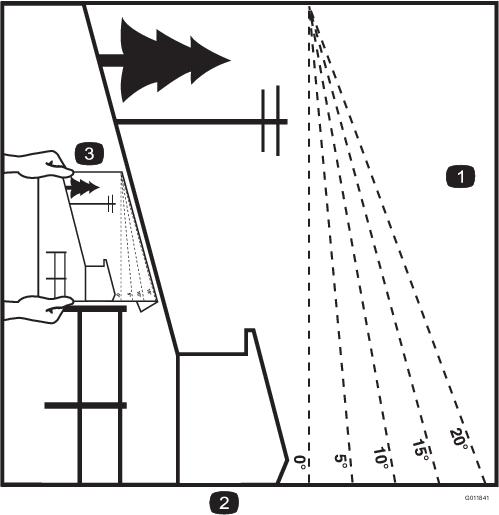
Safety and Instructional Decals
 |
Safety decals and instructions are easily visible to the operator and are located near any area of potential danger. Replace any decal that is damaged or missing. |





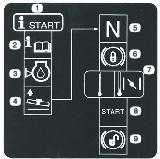




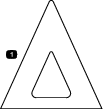
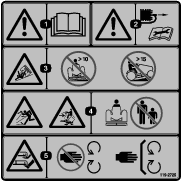



Product Overview
Become familiar with the controls (Figure 4) before you start the engine and operate the machine.

| Weight | 246 kg |
| Length | 246 kg |
| Width | 110 cm |
| Cutting width | 102 cm |
| Height | 115 cm |
| Engine speed | 2,600 rpm |
| Nominal engine power | 10.17 Kw at 3,000 rpm |
Operation
Note: Determine the left and right sides of the machine from the normal operating position.
Filling the Fuel Tank
-
For best results, use only clean, fresh (less than 30 days old), unleaded gasoline with an octane rating of 87 or higher ((R+M)/2 rating method).
-
Ethanol: Gasoline with up to 10% ethanol (gasohol) or 15% MTBE (methyl tertiary butyl ether) by volume is acceptable. Ethanol and MTBE are not the same. Gasoline with 15% ethanol (E15) by volume is not approved for use. Never use gasoline that contains more than 10% ethanol by volume, such as E15 (contains 15% ethanol), E20 (contains 20% ethanol), or E85 (contains up to 85% ethanol ). Using unapproved gasoline may cause performance problems and/or engine damage which may not be covered under warranty.
-
Do not use fuel containing methanol.
-
Do not store fuel either in the fuel tank or fuel containers over the winter unless a fuel stabilizer is used.
-
Do not add oil to the fuel.
Important: To reduce starting problems, add fuel stabilizer to the fuel all season, mixing it with fuel less than 30 days old; run the machine dry before storing it for more than 30 days.Do not use fuel additives other than a fuel stabilizer/conditioner. Do not use fuel stabilizers with an alcohol base such as ethanol, methanol, or isopropanol.
Danger
Fuel and fuel vapors are extremely flammable and explosive. A fire or explosion from fuel can burn you and others.
-
To prevent a static charge from igniting the fuel, place the container and/or machine directly on the ground before filling, not in a vehicle or on an object.
-
Fill the tank outdoors when the engine is cold. Wipe up spills.
-
Do not handle fuel when smoking or around an open flame or sparks.
-
Store fuel in an approved fuel container, out of the reach of children.
-
Stop the engine and wait for all moving parts to stop.
-
Clean around the fuel tank cap and remove it.
-
Add unleaded regular gasoline to the fuel tank until the level is 1/4 to 1/2 inch (6 to 13 mm) below the bottom of the filler neck. Do not fill the fuel tank completely full.
Important: Do not fill the fuel tank completely full. This space in the tank allows fuel to expand.
-
Install the fuel tank cap securely.
-
Wipe up any fuel that may have spilled.
Important: Do not start the engine if there are fuel spills, open containers of fuel, or other flammable liquids or gases in the immediate vicinity of the machine.
Checking the Engine Oil Level
Before you start the engine and use the machine, check the oil level in the engine crankcase; refer to Checking the Engine Oil Level.
Using the Parking Brake
Always set the parking brake whenever you stop the machine or leave it unattended.
Setting the Parking Brake
Positioning the Seat
The seat can move forward and backward. Position the seat where you have the best control of the machine and are most comfortable.
-
Raise the seat and loosen the adjustment knobs (Figure 6).
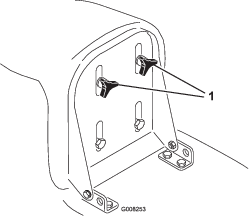
-
Move the seat to the desired position and tighten the knobs.
Operating the Headlights
The headlights are an integral function of the ignition switch. Turn the ignition key clockwise to the Lights position.
Using the Blade Control (PTO)
The blade control (PTO) knob engages and disengages power to the blades.
Engaging the Blades
-
Depress the brake pedal to stop the machine.
-
Pull the blade control (PTO) knob out to the Engaged position (Figure 4).
Disengaging the Blades
-
Depress the brake pedal to stop the machine.
-
Push the blade control (PTO) knob into the Disengaged position (Figure 4).
Setting the Height of Cut
Use the height-of-cut lever to raise and lower the mower to the desired cutting height. You can set the cutting height to 7 different positions from approximately 30 to 80 mm (1-1/4 to 3-1.8 inches).
Important: You must set the height-of-cut lever to the highest position (7) when you transport the machine off the lawn to prevent damaging the blades.
-
Push and hold in the button on the height-of-cut lever (Figure 7).
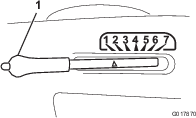
-
Shift the height-of-cut lever to the desired position.
-
Release the button.
Starting the Engine
-
Open the fuel shut-off valve located between the fuel tank and the engine (Figure 8).
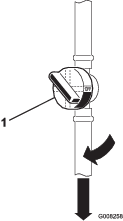
Note: The valve handle should align with the fuel hose.
-
Sit down on the seat.
-
Ensure the traction control pedals are in the Neutral position.
-
Set the parking brake; refer to Setting the Parking BrakeSetting the Parking Brake.
-
Disengage the blades (PTO); refer to Figure 4.
Note: The engine will not start if the blades (PTO) are engaged.
-
When starting a cold engine, push the throttle control lever fully forward to the choke position (Figure 9).
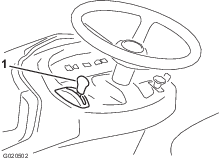
Note: To start a warm engine, pull the throttle control lever back to the fast position.
-
Turn the ignition key clockwise and hold it in the Start position (Figure 10).
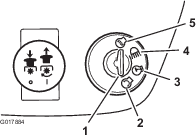
Note: When the engine starts, release the key.
Important: If the engine does not start after 15 seconds of continuous cranking, turn the ignition key to Off and let the starter motor cool for 2 minutes; refer to .
-
After the engine starts, slowly shift the throttle control lever to the Fast position (Figure 9).
Stopping the Engine
-
Move the throttle control lever to the Slow position (Figure 9).
Note: If the engine backfires, shift the throttle control lever to the Fast position before stopping the engine.
-
Turn the ignition key to the Off position (Figure 9).
Note: If the engine has been working hard or is hot, let it idle for a minute before turning the ignition key to the Off position. This allows the engine to cool the engine before you stop it. You may stop the engine in an emergency by turning the ignition key to the Off position.
Using the Safety Interlock System
Caution
If the safety interlock switches are disconnected or damaged, the machine could operate unexpectedly, causing personal injury.
-
Do not tamper with the interlock switches.
-
Check the operation of the interlock switches daily and replace any damaged switches before operating the machine.
-
Replace switches every 2 years regardless of whether they are operating properly or not.
Understanding the Safety Interlock System
The safety interlock system is designed to prevent the engine from starting unless:
-
You are sitting on the seat.
-
The brake pedal is depressed.
-
The blade control (PTO) knob is in the Disengaged position.
-
The traction control pedal is in the Neutral position.
The safety interlock system stops the engine if you rise from the seat and the traction control pedal is not in the Neutral position, the parking brake is not set, or the blade control (PTO) knob is in the Engaged position.
The safety interlock system is designed to stop the mower if:
-
You shift into Reverse with the blades (PTO) engaged.
-
You remove the bag or dump the grass.
Setting the KeyChoice
The interlock feature on the machine prevents the power take-off (PTO) from operating when you back up the machine. If you operate the machine in reverse with the blades (PTO) engaged (i.e., with the mower blades or other attachment running), the blades will stop. Do not mow in reverse unless it is absolutely necessary.
If you need to use the blades (PTO) while backing up, turn off the interlock feature using the KeyChoice switch located near the seat bracket (Figure 11).
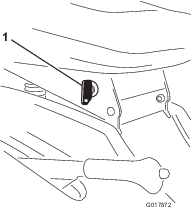
Danger
You could back over a child or bystander while the mower blades or other attachment is engaged and cause serious injury or death.
-
Do not mow in reverse unless it is absolutely necessary.
-
Do not insert the KeyChoice key unless it is absolutely necessary.
-
Always look backward and down before backing up the machine.
-
Use the KeyChoice switch only if you are certain that no children or other bystanders will enter the mowing area.
-
Be very observant after deactivating the interlock because the sound of the engine may prevent you from noticing that a child or bystander has entered the work area.
-
Always remove both the ignition and KeyChoice keys and put them in a safe place out of the reach of children or unauthorized users when you leave the machine unattended.
-
Engage the blades (PTO).
-
Insert the KeyChoice key into the switch (Figure 11).
-
Turn the KeyChoice key.
Note: A red light on the front console (Figure 12) turns on, indicating that the interlock is disabled.

-
Operate the machine in reverse and complete your task.
-
Disengage the blades (PTO) to activate the interlock.
-
Remove the KeyChoice key and put it in a safe place out of the reach of children.
Testing the Safety Interlock System
Caution
If the safety interlock switches are disconnected or damaged, the machine could operate unexpectedly, causing personal injury.
-
Do not tamper with the interlock switches.
-
Check the operation of the interlock switches daily and replace any damaged switches before operating the machine.
Test the safety interlock system before you use the machine each time. If the safety interlock system does not operate as described below, have an Authorized Service Dealer repair the safety interlock system immediately. Do not operate the machine until it has been repaired. While sitting in the seat, perform the following checks:
-
Set the parking brake, shift the blade control (PTO) knob to the Engage position, and turn the ignition key to Start: The engine should not crank.
-
Shift the blade control (PTO) knob to the Disengage position, release the parking brake, and turn the ignition key to Start: The engine should not crank.
-
Set the traction pedal to the neutral position, set the parking brake, shift the blade control (PTO) knob to Disengage, and start the engine. While the engine is running, release the parking brake and rise slightly from the seat: The engine should stop.
-
With the parking brake set, shift the blade control (PTO) knob into the Disengage position, put the traction control pedal in the Neutral position, and start the engine. While the engine is running, shift the blade control (PTO) knob into the Engage position and put the traction control pedal in the Reverse position: The engine should stop.
-
With the parking brake set, shift the blade control (PTO) knob into the Disengage position and put the traction control pedal in the Neutral position. Start the engine, shift the blade control (PTO) knob into the Engage position, and turn the KeyChoice key and release it: The operating-in-reverse warning light should illuminate.
-
Shift the blade control (PTO) knob to the Disengage position: The operating-in-reverse warning light should turn off.
Pushing the Machine Manually
Important: Always push the machine manually. Never tow the machine because it may damage the transaxle.
To Push the Machine
-
Park the machine on a level surface.
-
Disengage the blades (PTO).
-
Set the parking brake.
-
Stop the engine and wait for all moving parts to stop.
-
Remove the ignition key.
-
Remove the grass collector; refer to Removing the Grass Collector.
-
Push the drive control (located at the rear of the machine), in to the Push position.
-
Release the parking brake.
Note: This disengages the drive system and allows the wheels to turn freely (Figure 13).
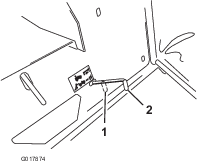
To Operate the Machine
-
Set the parking brake.
-
Pull the drive control into the Operate position (Figure 13) to engage the drive system.
Note: The machine will not drive unless the drive control is in the Operate position.
-
Install the grass collector; refer to Installing the Grass Collector.
Driving the Machine Forward or Backward
The throttle control regulates the engine speed as measured in RPM (revolutions per minute). Place the throttle control in the Fast position for best performance.
To go forward:
-
Release the parking brake; refer to Releasing the Parking Brake.
-
Place your foot on the forward speed pedal and slowly press on the pedal to move forward (Figure 14).
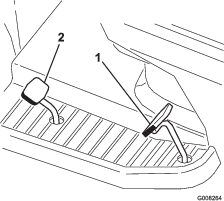
Note: To increase the speed, push the forward speed pedal down. To decrease the speed, release the pressure on the traction control pedal.
To go backward:
-
Release the parking brake; refer to Releasing the Parking Brake.
-
Place your foot on the reverse speed pedal and slowly press on the pedal to move backward (Figure 14).
Note: To increase the speed, push the reverse speed pedal down. To decrease the speed, release the pressure on the reverse speed pedal.
Important: To avoid transmission damage, always release the parking brake before moving the traction control pedal or the reverse speed pedal.
Important: To prevent damage to the mower, always set the mower to the highest cutting position when you drive the machine off the lawn.
Stopping the Machine
-
Release the traction control pedal or reverse speed pedal.
-
Disengage the blades (PTO).
-
Turn the ignition key to the Off position.
-
Set the parking brake if you leave the machine unattended; refer to Setting the Parking Brake.
Note: Remove the keys from the ignition and KeyChoice switches.
Caution
Children or bystanders may be injured if they move or attempt to operate the machine while it is unattended.
Always remove the ignition and KeyChoice keys and set the parking brake when leaving the machine unattended, even if it is just for a few minutes.
Using the Recycle on Demand
You can activate or deactivate the recycle-on-demand feature while the machine is mowing or is stopped. If you are bagging grass that is tall and thick, raise the height-of-cut and mow at a slower speed.
-
Move the recycle-on-demand lever (Figure 4) forward to collect the grass clippings.
-
Move the recycle-on-demand lever rearward to stop collecting the grass clippings and recycle them.
Emptying the Grass Collector
When the grass collector is full, a buzzer sounds and the grass collector must be emptied.
Important: To prevent the discharge tunnel from getting clogged, disengage the blades (PTO) when the buzzer sounds.
-
Disengage the locking latch (Figure 15).
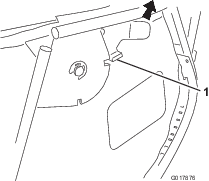
-
Disengage the blades (PTO) and move the throttle to the Slow position.
-
Pull the grass collector dump lever forward and tilt the grass collector (Figure 16).

-
Empty the grass collector.
-
Before returning the grass collector to the operating position, move the machine forward to clear the grass collector of the deposited grass.
-
Slowly lower the dump lever to return the grass collector to the operating position.
Rear-Discharging the Grass Clippings
Occasionally, you may need to cut the lawn without the grass collector when the grass is too long for collecting.
-
Disengage the locking latch (Figure 17).

-
Disengage the blades (PTO) and move the throttle to the Slow position.
-
Pull the grass collector dump lever forward and tilt the grass collector (Figure 18) until the locking latch engages to lock the grass collector in the open position (Figure 19).

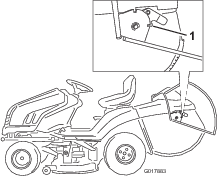
-
Mow the grass with the grass collector in the open position as desired.
-
Before returning the grass collector to the operating position, move the machine forward to clear the grass collector of the deposited grass.
-
Slowly lower the dump lever to return the grass collector to the operating position.
Using the Optional Towing Hitch
The machine is capable of towing non-ground-engaging attachments with a maximum weight of 150 kg (331 lb).
-
Remove the grass collector; refer to Removing the Grass Collector.
-
Install the attachment to the towing hitch located at the lower rear part of the machine (Figure 20).

Operating Tips
-
For the best performance, operate the engine at the maximum speed. The mower requires air to thoroughly cut grass clippings, so do not set the height-of-cut too low or completely surround the mower in uncut grass. Always leave one side of the mower free from uncut grass to allow the air to be drawn into the mower.
-
Cut the grass slightly longer than normal to ensure that the cutting height of the mower does not scalp any uneven ground. When cutting grass longer than 6 inches (15 cm) tall, cut the lawn twice to ensure an acceptable appearance.
-
It is best to cut only about 1/3 of the grass blade. Do not cut more than that unless the grass is sparse or it is late fall when grass grows more slowly.
-
Alternate the mowing direction to keep the grass standing straight. This also helps disperse clippings and enhances decomposition and fertilization.
-
Grass grows at different rates at different times of the season. To maintain the same cutting height, which is a good practice, mow more often in early spring. As the grass growth rate slows in mid summer, mow less frequently.
-
If the grass is longer than normal, or if it contains a high degree of moisture, raise the cutting height higher than usual, cut the grass at that setting, and then cut the grass again at the lower, normal setting.
-
If you must stop the machine while mowing, you may leave a clump of grass clippings on your lawn. To avoid this, do the following:
-
Engage the blades and move to a previously cut area.
-
Disperse the clippings evenly by raising the mower 1 or 2 height-of-cut settings while driving forward with the blades engaged.
-
-
Use the washout port to clean clippings and dirt from the underside of the mower after each use. If grass and dirt build up inside the mower, the cutting quality will eventually become unsatisfactory.
-
Maintain sharp blades throughout the season. Sharp blades cut grass cleanly without tearing or shredding the grass blades. Tearing and shredding the grass turns it brown at the edges, which slows its growth and increases the chance of disease. Every 30 days, check the blades for sharpness and file down any nicks.
Maintenance
Note: Determine the left and right sides of the machine from the normal operating position.
Recommended Maintenance Schedule(s)
| Maintenance Service Interval | Maintenance Procedure |
|---|---|
| After the first 5 hours |
|
| Before each use or daily |
|
| Every 25 hours |
|
| Every 50 hours |
|
| Every 100 hours |
|
| Yearly or before storage |
|
Important: Refer to your engine operator’s manual for additional maintenance procedures.
Caution
If you leave the key in the ignition switch, someone could accidently start the engine and seriously injure you or other bystanders.
Remove the key from the ignition and disconnect the wire from the spark plug before you do any maintenance. Set the wire aside so that it does not accidentally contact the spark plug.
Lubrication
Greasing and Lubricating the Machine
| Maintenance Service Interval | Maintenance Procedure |
|---|---|
| Every 25 hours |
|
How to Grease the Machine
Note: Grease the machine with a general-purpose grease.
-
Disengage the blades (PTO).
-
Set the parking brake.
-
Stop the engine and wait for all moving parts to stop.
-
Remove the ignition key.
-
Clean the grease fittings with a rag, and scrape any paint off the front of the fittings.
-
Connect a grease gun to each fitting and pump grease into it.
-
Wipe up any excess grease.
Where to Add Grease
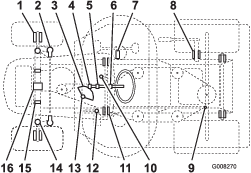
Grease Locations
| Item | Name | Quantity (pumps) | Interval (hours) | Lubricant |
| 1 | Front wheel—grease fittings | 2 | 25 | Grease |
| 2 | Steering ball joints | 4 | 50 | Oil |
| 3 | Steering sector gear | 1 | 50 | Grease |
| 4 | Steering pinion gear | 1 | 25 | Grease |
| 5 | Steering shaft bearing | 1 | 50 | Oil |
| 6 | Steering shaft bearing | 1 | 50 | Oil |
| 7 | Motion lever | 1 | 50 | Grease |
| 8 | Shaft hub for lifting the mower housing | 1 | 50 | Oil |
| 9 | Motion link ball joints | 4 | 50 | Oil |
| 10 | Traction idler pulley belt—grease fitting | 1 | 50 | Grease |
| 11 | Brake pedal shaft pivot points | 2 | 50 | Oil |
| 12 | Parking brake ring | 1 | 50 | Oil |
| 13 | Steering bearing | 1 | 25 | Grease |
| 14 | Left and Right Spindle—grease fittings | 2 | 25 | Grease |
| 15 | Mower housing hinged pins | 6 | When removed | Grease |
| 16 | Front axle pivot pins | 2 | When removed | Grease |
Engine Maintenance
Servicing the Air Cleaner
| Maintenance Service Interval | Maintenance Procedure |
|---|---|
| Every 25 hours |
|
| Every 100 hours |
|
-
Park the machine on a level surface.
-
Disengage the blades (PTO).
-
Set the parking brake.
-
Stop the engine and wait for all moving parts to stop.
-
Remove the ignition key.
-
Allow the engine to cool.
-
Open the hood.
Removing the Foam and Paper Elements
-
Clean around the air cleaner to prevent dirt from getting into the engine and causing damage.
-
Pull up on the air cleaner cover handle and rotate it toward the engine (Figure 22).
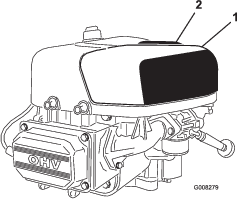
-
Remove the air cleaner cover.
-
Carefully slide the paper element and the foam element from the blower housing (Figure 23).
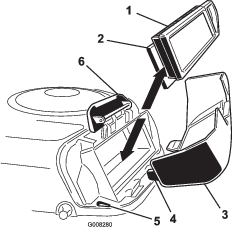
Cleaning the Foam and Paper Elements
Foam Element
-
Wash the foam element in liquid soap and warm water and rinse it thoroughly.
-
Dry the element by squeezing it in a clean cloth.
Note: Do not oil the foam element.
Important: Replace the foam element if it is torn or worn.
Paper Element
-
Lightly tap the paper element on a flat surface to remove dust and dirt.
-
Inspect the element for tears, an oily film, and damage to the rubber seal.
Important: Never clean the paper element with pressurized air or liquids such as solvents, gasoline, or kerosene. Replace the paper element if it is damaged or cannot be cleaned thoroughly.
Installing the Foam and Paper Elements
Important: To prevent engine damage, always operate the engine with the complete foam and paper air cleaner assembly installed.
-
Place the foam element and paper element into the blower housing.
Note: Ensure that the rubber seal is flat against the air cleaner base.
-
Align the tabs on the air cleaner cover with the slots of the blower housing (Figure 23).
-
Hook the handle onto the cover and press down on the handle to lock the cover in place.
Servicing the Engine Oil
Oil Type: Detergent oil (API classification SJ or higher)
Crankcase capacity: 1.4 L (47 oz) with filter; 1.3 L (44 oz) without filter
Viscosity: See the oil table (Figure 24).

Checking the Engine Oil Level
| Maintenance Service Interval | Maintenance Procedure |
|---|---|
| Before each use or daily |
|
-
Park the machine on a level surface.
-
Disengage the blades (PTO).
-
Set the parking brake.
-
Stop the engine and wait for all moving parts to stop.
-
Remove the ignition key.
-
Open the hood.
-
Clean around the dipstick (Figure 25) so that dirt cannot fall into the filler hole and damage the engine.
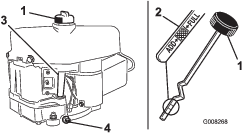
-
Unscrew the dipstick and wipe the metal end clean (Figure 25).
-
Screw the dipstick fully onto the filler tube (Figure 25).
-
Unscrew the dipstick again and look at the metal end. If the engine oil level is low, slowly pour only enough oil into the filler tube to raise the level to the Full mark on the dipstick.
Important: Do not overfill the crankcase with engine oil and run the engine; engine damage may result.
Changing the Engine Oil
| Maintenance Service Interval | Maintenance Procedure |
|---|---|
| After the first 5 hours |
|
| Every 50 hours |
|
-
Start the engine and let it run for 5 minutes.
Note: This warms the oil so that it drains better.
-
Park the machine so that the drain side is slightly lower than the other side to ensure that the oil drains completely.
-
Disengage the blades (PTO).
-
Set the parking brake.
-
Stop the engine and wait for all moving parts to stop.
-
Remove the ignition key.
-
Open the hood.
-
Place a pan below the drain plug.
-
Remove the drain plug to allow the oil to drain (Figure 25).
-
When the oil has drained completely, insert the drain plug and tighten it securely.
Note: Recycle the used engine oil properly.
-
Clean around the dipstick and unscrew the cap (Figure 25).
-
Slowly pour approximately 80% of the engine oil into the filler tube (Figure 25).
-
Check the engine oil level; refer to steps 9 and 10 of Checking the Engine Oil Level.
Changing the Engine Oil Filter
| Maintenance Service Interval | Maintenance Procedure |
|---|---|
| Every 100 hours |
|
-
Drain the oil from the engine; refer to Changing the Engine Oil.
-
Remove the old filter and wipe off the adapter gasket surface (Figure 26).
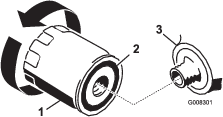
-
Apply a thin coat of new engine oil to the rubber gasket on the new filter (Figure 26).
-
Install the new filter to the filter adapter by turning it clockwise until the gasket contacts the filter adapter.
-
Tighten the filter an additional 1/2 to 3/4 turn (Figure 26).
-
Fill the crankcase with the proper type of new engine oil; refer to Checking the Engine Oil Level.
Servicing the Spark Plug
| Maintenance Service Interval | Maintenance Procedure |
|---|---|
| Every 25 hours |
|
| Every 100 hours |
|
Use a Champion RC12YC or equivalent spark plug. Ensure that the air gap between the center and side electrodes is 0.030 inch (0.76 mm) before installing the spark plug. Use a spark plug wrench for removing and installing the spark plug and a gapping tool or feeler gauge to check and adjust the air gap.
Removing the Spark Plug
-
Disengage the blades (PTO).
-
Set the parking brake.
-
Stop the engine and wait for all moving parts to stop.
-
Remove the ignition key.
-
Open the hood.
-
Disconnect the wire from the spark plug (Figure 27).
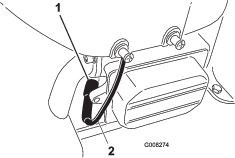
-
Clean around the spark plug to prevent dirt from falling into the engine and potentially causing damage.
-
Remove the spark plug and the metal washer (Figure 27).
Checking the Spark Plug
-
Look at the center of the spark plug (Figure 28). If you see light brown or gray on the insulator, the engine is operating properly. A black coating on the insulator usually means that the air cleaner is dirty.
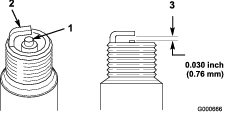
Important: Do not clean the spark plug. Always replace the spark plug when it has a black coating, worn electrodes, an oily film, or cracks.
-
Check the gap between the center and side electrodes (Figure 28) and bend the side electrode if the gap is not correct.
Installing the Spark Plug
-
Install the spark plug and metal washer. Ensure that the air gap is set correctly.
-
Tighten the spark plug to 15 ft-lb (20.4 N-m).
-
Connect the wire to the spark plug (Figure 27).
-
Close the hood.
Fuel System Maintenance
Draining the Fuel Tank
Drain the fuel tank when you will not be using the machine for more than 30 days.
Danger
In certain conditions, fuel and fuel vapors are extremely flammable and highly explosive. A fire or explosion from fuel can burn you and others and can damage property.
-
Drain fuel from the fuel tank when the engine is cold. Do this outdoors in an open area. Wipe up any fuel that spills.
-
Never smoke when draining fuel, and stay away from an open flame or where a spark may ignite the fuel fumes.
-
Park the machine so that the left front side is slightly lower than the right side to ensure that the fuel tank drains completely.
-
Disengage the blades (PTO).
-
Set the parking brake.
-
Stop the engine and wait for all moving parts to stop.
-
Remove the ignition key.
-
Close the fuel shut-off valve located under the front of the fuel tank.
-
Loosen the hose clamp at the fuel filter and slide it up the fuel line away from the fuel filter (Figure 29).
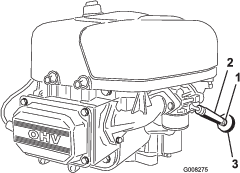
-
Pull the fuel line off the fuel filter (Figure 29).
-
Open the fuel shut-off valve and allow the fuel to drain into an approved fuel container or a drain pan.
Note: Now is the best time to install a new fuel filter because the fuel tank is empty.
-
Install the fuel line onto the fuel filter.
-
Slide the hose clamp close to the fuel filter to secure the fuel line (Figure 29).
Replacing the Fuel Filter
| Maintenance Service Interval | Maintenance Procedure |
|---|---|
| Every 100 hours |
|
The best time to replace the fuel filter (Figure 29) is when the fuel tank is empty. Never install a dirty fuel filter after it has been removed from the fuel line.
-
Park the machine on a level surface.
-
Disengage the blades (PTO).
-
Set the parking brake.
-
Stop the engine and wait for all moving parts to stop.
-
Remove the ignition key.
-
Close the fuel shut-off valve (Figure 30).

-
Squeeze the ends of the hose clamps together and slide them away from the old fuel filter (Figure 30).
-
Remove the old fuel filter from the fuel line.
-
Install a new fuel filter and move the hose clamps close to it.
-
Open the fuel shut-off valve.
Electrical System Maintenance
Replacing the Headlight Bulbs
-
Disengage the blades (PTO).
-
Set the parking brake.
-
Stop the engine and wait for all moving parts to stop.
-
Remove the ignition key.
-
Open the hood.
-
Pull out the bulb socket (Figure 31).
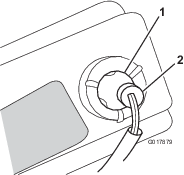
-
Bend the wire tabs in the metal sleeve (that hold the bulb in place) out of the way; refer to Figure 32.
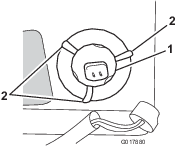
-
Remove the old light bulb.
-
Install a new light bulb.
-
Bend the wire tabs in behind the bulb to hold it in place.
-
Install the bulb socket.
Replacing the Fuses
The electrical system is protected by fuses. They are located beneath the hood, near the fuel tank (Figure 33). If a fuse goes out, check the circuit wiring for a short.
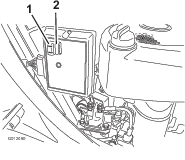
To replace a fuse, pull up to remove the old fuse from the socket. Insert a new fuse by pushing it down into the socket.
Note: Ensure that the new fuse has the same amperage as the old fuse that you are replacing.
Servicing the Battery
Important: Do not start the engine with a battery booster (jump starter) pack. Jump-starting the engine with a battery booster pack may damage electronic components of the machine.
Always keep the battery clean and fully charged. Use a paper towel to clean the battery and battery box. If the battery terminals are corroded, clean them with a solution of 4 parts water and 1 part baking soda. Apply a light coating of grease to the battery terminals to prevent them from corroding.
Battery voltage and amperage: 12 volts, 190 cold cranking amps
Removing the Battery
Warning
Battery terminals or metal tools could short against metal machine components causing sparks. Sparks can cause the battery gasses to explode, resulting in personal injury.
-
When removing or installing the battery, do not allow the battery terminals to touch any metal parts of the machine.
-
Do not allow metal tools to short between the battery terminals and the metal parts of the machine.
-
Disengage the blades (PTO).
-
Set the parking brake.
-
Stop the engine and wait for all moving parts to stop.
-
Remove the ignition key.
-
Lift up the seat to see the battery.
-
Lift the rubber cover up off the negative (black) cable.
-
Disconnect the negative (black) ground cable from the battery post (Figure 34).
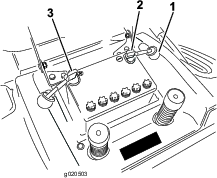
Warning
Routing the battery cables improperly could damage the machine and cables, causing sparks. Sparks can cause the battery gasses to explode, resulting in personal injury.
-
Always disconnect the negative (black) battery cable before disconnecting the positive (red) cable.
-
Always connect the positive (red) battery cable before connecting the negative (black) cable.
-
-
Lift the rubber cover up off the positive (red) cable.
-
Disconnect the positive (red) cable from the battery post (Figure 34).
-
Remove the battery hold down rod.
-
Remove the battery from the chassis.
Installing the Battery
-
Place the battery into the chassis with the battery posts toward the rear of the machine (Figure 34).
-
Secure the battery in the chassis with the hold down rod.
-
Using the bolt and wing nut, connect the positive (red) cable to the positive (+) battery post (Figure 34). Slide the rubber cover over the battery post.
-
Using the bolt and wing nut, connect the negative (black) cable to the negative (–) battery post (Figure 34). Slide the rubber cover over the battery post.
Checking the Electrolyte Level
| Maintenance Service Interval | Maintenance Procedure |
|---|---|
| Before each use or daily |
|
-
Tip the seat forward to see the battery.
-
Look at the side of the battery. The electrolyte must be up to the upper line (Figure 35).

Note: Do not allow the electrolyte to fall below the lower line (Figure 35).
-
If the electrolyte is low, add the required amount of distilled water; refer to Adding Water to the Battery.
Danger
Battery electrolyte contains sulfuric acid which is a deadly poison and causes severe burns.
-
Do not drink electrolyte and avoid contact with skin, eyes or clothing. Wear safety glasses to shield your eyes and rubber gloves to protect your hands.
-
Fill the battery where clean water is always available for flushing the skin.
-
Adding Water to the Battery
The best time to add distilled water to the battery is just before you operate the machine. This lets the water mix thoroughly with the electrolyte solution.
-
Clean the top of the battery with a paper towel.
-
Remove the filler caps (Figure 35).
-
Slowly pour distilled water into each battery cell until the level is up to the lower part of the tube (Figure 35).
Important: Do not overfill the battery. Electrolyte (sulfuric acid) can severely corrode and damage the chassis.
-
Install the filler caps.
Charging the Battery
Warning
Charging the battery produces gasses that can explode. Never smoke near the battery and keep sparks and flames away from the battery.
Important: Always keep the battery fully charged (1.260 specific gravity), especially below 32°F (0°C) to prevent battery damage.
-
Remove the battery from the chassis; refer to Removing the Battery.
-
Check the electrolyte level; refer to Checking the Electrolyte Level.
-
Remove the filler caps from the battery and connect a 2 A battery charger to the battery posts.
-
Charge the battery at a rate of 2 A or less for 24 hours (12 volts).
Important: Use only a battery charger set to 12 volts to charge the battery.
-
When the battery is fully charged, install the filler caps.
-
Install the battery in the chassis; refer to Installing the Battery.
Drive System Maintenance
Checking the Tire Pressure
| Maintenance Service Interval | Maintenance Procedure |
|---|---|
| Every 25 hours |
|
Maintain the air pressure in the front tires at 103 kPa (15 psi) and rear tires at 83 kPa (12 psi). Check the pressure at the valve stem (Figure 36). Check the tires when they are cold to get the most accurate pressure reading.

Servicing the Brake
The brake is located on the right side of the rear axle, inside the rear tire (Figure 37).

Note: If the machine takes more than 1 m (3 ft) to stop at high speed in the highest gear, adjust the brake.
Checking the Brake
| Maintenance Service Interval | Maintenance Procedure |
|---|---|
| Before each use or daily |
|
-
Park the machine on a level surface.
-
Disengage the blades (PTO).
-
Set the parking brake.
-
Stop the engine and wait for all moving parts to stop.
-
Remove the ignition key.
-
Pull the drive control out to the Push position (Figure 13).
-
If the rear wheels lock and skid when you push the machine forward, you do not need to adjust the brake. If the wheels turn and do not lock, adjust the brake; refer to Adjusting the Brake.
Adjusting the Brake
-
Check the brake before you adjust it; refer to Checking the Brake.
-
Ensure that the drive control is in the Operate position (Figure 13) and that the parking brake is on.
-
Turn the brake adjusting nut clockwise until you cannot push the machine (Figure 37).
-
Release the parking brake and ensure that the rear wheels rotate freely when you push the machine. If they do not, turn the brake adjusting nut counterclockwise just enough so that you can push the machine.
-
Check the brake operation again; refer to Checking the Brake.
Servicing the Grass Collector
Removing the Grass Collector
-
Lock the locking latch on the grass collector (Figure 38).

-
Lift up the collector using the top support bar.
Installing the Grass Collector
-
Hang the top support bar onto the 2 notches in the support bracket at the rear of the machine (Figure 39).
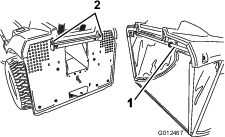
Note: Ensure that the grass collector is properly seated on the mower. The mower will not function unless the grass collector is properly attached.
-
Unlock the locking pin to allow for emptying the grass collector.
Cleaning the Grass Collector and Tunnel
-
Disengage the blades (PTO).
-
Set the parking brake.
-
Stop the engine and wait for all moving parts to stop.
-
Remove the ignition key.
-
Remove the grass collector; refer to Removing the Grass Collector.
-
Clean the collector bag with pressurized water.
-
Wipe the area around the full-bag sensor.
-
Clean the inside of the discharge tunnel all the way to the mower.
-
Install the grass collector; refer to Removing the Grass Collector.
Note: Allow the bag to dry thoroughly before installing it.
Mower Deck Maintenance
Servicing the Blades
| Maintenance Service Interval | Maintenance Procedure |
|---|---|
| Before each use or daily |
|
Note: Determine the left and right sides of the machine from the normal operating position.
To ensure a superior quality of cut, keep the blades sharp. For convenient sharpening and replacement, keep extra blades.
Danger
Worn or damaged blades can break and a piece of the blade could be thrown toward you or bystanders, resulting in serious personal injury or death.
-
Inspect the blades periodically for wear or damage.
-
Replace worn or damaged blades.
Inspecting the Blades
-
Remove the mower; refer to Removing the Mower.
-
Inspect the cutting edges (Figure 40). If the edges are not sharp or have nicks, remove the blades and sharpen them; refer to Sharpening the Blades.
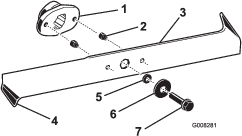
-
Inspect the blades, especially the bent edges (Figure 40). If you notice any wear or damage in this area, immediately install new blades.
-
If the shear pins are broken, replace them immediately (Figure 40).
Important: If the shear pins are broken, the mower belt may be damaged. Inspect the belt; refer to Removing the Mower.
Removing the Blades
-
Remove the mower; refer to Removing the Mower.
-
Carefully tip the mower over.
-
Remove the bolts, washers, and blades (Figure 40). Wedge a block of wood between each blade and the mower to lock the blade when you are removing each bolt.
Note: The right blade has a left-hand threaded bolt.
-
Inspect all parts; replace any that are worn or damaged.
Sharpening the Blades
-
Use a file to sharpen the cutting edge at both ends of each blade (Figure 41).
Note: Maintain the original angle. The blade retains its balance if you remove the same amount of material from both cutting edges.

-
Check the balance of each blade by putting it on a blade balancer (Figure 42).
Note: If the blade stays in a horizontal position, the blade is balanced and can be used. If the blade is not balanced, file some metal off the back side of the blade. Repeat this step until each blade is balanced.

Installing the Blades
-
Install the blades, washers, and blade bolts (Figure 40).
Important: Ensure that the right and left blades are installed in the proper positions with the bent edges of the blades pointing toward the top of the mower to ensure proper cutting.
-
Position the blades 90 degrees to each other (Figure 43).
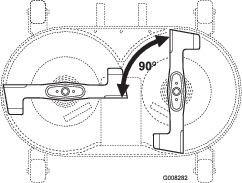
-
Tighten the blade bolts to 37 ft-lb (50 N∙m).
Removing the Mower
-
Park the machine on a level surface.
-
Disengage the blades (PTO).
-
Set the parking brake.
-
Stop the engine and wait for all moving parts to stop.
-
Remove the ignition key.
-
Disconnect the wire from the spark plug.
-
Move the height-of-cut lever to the lowest position.
-
Remove the tunnel.
-
Pull the idler arm assembly inward and remove the V-belt from the pulley (Figure 44).

-
Remove both pins between the rear arm and the deck.
Important: The relief spring is very strong. Wedge the mower housing to ensure that it does not fly upward and cause damage.
-
Remove the pin between the front arm linkage and the mower housing (Figure 44).
-
Remove the V-belt from the engine pulley (Figure 44).
-
Slide the mower out from beneath the machine.
Installing the Mower
Reverse the procedure for Removing the Mower.
Storage
-
Disengage the blades (PTO).
-
Set the parking brake.
-
Stop the engine and wait for all moving parts to stop.
-
Remove the ignition key.
-
Remove the grass collector and clean it; refer to Removing the Grass Collector.
-
Remove grass clippings, dirt, and grime from the external parts of the entire machine, especially the engine. Clean the dirt and chaff from the outside of the engine cylinder head fins and blower housing.
Important: You can wash the machine with a mild detergent and water. Do not use pressurized liquids to wash the machine. Pressurized liquids may damage the electrical system or wash away necessary grease at the friction points. Avoid using water excessively, especially near the control panel, lights, engine, and battery.
-
Check the brake; refer to Checking the Brake.
-
Service the air cleaner; refer to Servicing the Air Cleaner.
-
Grease the chassis; refer to Greasing and Lubricating the Machine.
-
Change the engine oil and filter; refer to Changing the Engine Oil and Changing the Engine Oil Filter.
-
Check the tire pressure; refer to Checking the Tire Pressure.
-
When storing the machine over 30 days, prepare it as follows:
-
Add a petroleum-based stabilizer/conditioner to the fuel in the tank according to the instructions from the stabilizer manufacturer. Do not use an alcohol-based stabilizer (ethanol or methanol).
Note: A fuel stabilizer/conditioner is most effective when mixed with fresh fuel and used at all times.
-
Run the engine for 5 minutes to distribute the conditioned fuel through the fuel system.
-
Stop the engine, allow it to cool, and drain the fuel tank; refer to Draining the Fuel Tank.
-
Start the engine and run it until it stops.
-
Choke or prime the engine.
-
Start and run the engine until it will not start again.
-
Recycle the old fuel according to local codes.
-
Close the fuel shut-off valve.
Important: Do not store stabilizer/conditioned fuel over 90 days.
-
-
Remove and inspect the spark plug; refer to Servicing the Spark Plug. With the spark plug removed from the engine, pour 2 tablespoons of engine oil into the spark plug hole. Use the electric starter to crank the engine and distribute the oil inside the cylinder. Install the spark plug, but do not connect the wire to the spark plug.
-
Disconnect the negative battery cable. Clean the battery and battery terminals. Check the electrolyte level and charge it fully; refer to Servicing the Battery. Leave the negative battery cable disconnected from the battery during storage.
Important: The battery must be fully charged to prevent it from freezing and being damaged at temperatures below 32°F (0°C). You can store a fully charged battery during the winter without recharging.
-
Check and tighten all bolts, nuts, and screws. Repair or replace any part that is worn or damaged.
-
Paint all scratched or bare metal surfaces with paint available from an Authorized Service Dealer.
-
Store the machine in a clean, dry garage or storage area. Remove the ignition and KeyChoice keys from the mower and keep them in a memorable place. Cover the machine to protect it and keep it clean.
Troubleshooting
| Problem | Possible Cause | Corrective Action |
|---|---|---|
| The starter does not crank. |
|
|
| The engine overheats. |
|
|
| The machine does not drive. |
|
|
| The engine does not start, starts hard, or fails to keep running. |
|
|
| The engine loses power. |
|
|
| There is abnormal vibration. |
|
|
| The blades do not rotate. |
|
|
| The cutting height is uneven. |
|
|
Schematics
